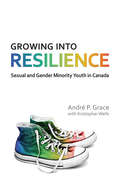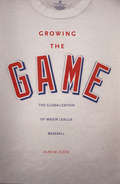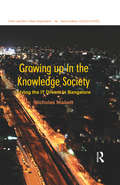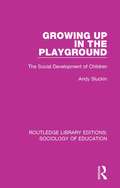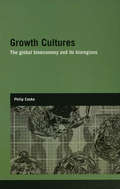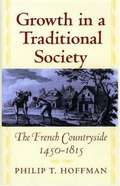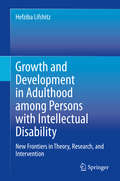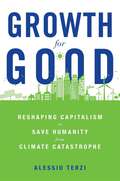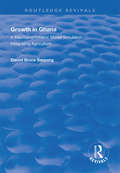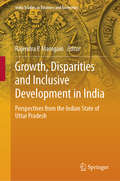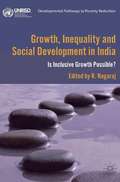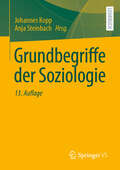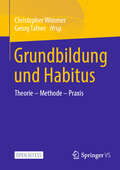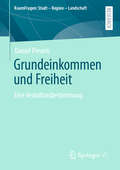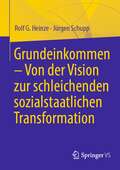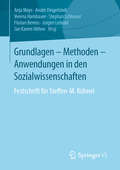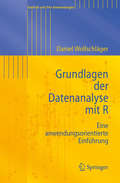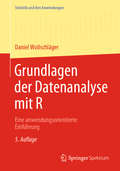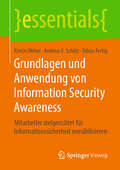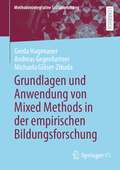- Table View
- List View
Growing Up on the Gridiron: Football, Friendship, and the Tragic Life of Owen Thomas
by Vicki MaykExplores the experience of one young man and the concerns about CTE he helped to illuminate, and the cultural allure of football in America that keeps boys trying to make the team despite the dangersAward-winning journalist Vicki Mayk raises a critical question for football players and their communities: does loving a sport justify risking your life? This is the insightful and deeply human story of Owen Thomas--a star football player at Penn, who took his own life when he was 21, the result of the pain and anguish caused by chronic traumatic encephalopathy (CTE).It was Owen's landmark case which demonstrated that a player didn't need years of head bashing in the NFL, or even multiple sustained brain concussions, to cause the mind-altering, life-threatening, degenerative disease known as CTE. And Owen's case could not have come to light without Dr. Ann McKee, the neuropathologist who bucked conventional wisdom, and the football establishment, as she examined Owen's brain and its larger significance, building an ever-stronger case that said, at the very least, football should not be played by children under the age of 14.With its focus on a single life and the community touched by it--Owen's family, his teammates and friends, his teachers and coaches, and, later, Dr. McKee--Growing Up on the Gridiron explores the place of football in our lives. It doesn't make a heavy-handed argument to abandon the sport. Rather, it explores why football matters so deeply to many young men, and why they continue to take risks despite the evidence of serious, long-term harm.
Growing into Resilience
by Andre P. Grace Kristopher WellsDespite recent progress in civil rights for sexual and gender minorities (SGM), ensuring SGM youth experience fairness, justice, inclusion, safety, and security in their schools and communities remains an ongoing challenge. In Growing into Resilience, André P. Grace and Kristopher Wells - co-founders of Camp fYrefly, a summer leadership camp for SGM youth - investigate how teachers, healthcare workers, and other professionals can help SGM youth build the human and material assets that will empower them to be happy, healthy, and resilient.Grace and Wells investigate the comprehensive (physical, mental, and sexual) health of SGM youth, emphasizing the role of caring professionals in an approach that that recognizes and accommodates SGM youth. Throughout, the authors draw upon the personal narratives of SGM youth, emphasizing how research, policy, and practice must act together for them to be able to thrive and fulfill their promise.Both a resource for those professionally engaged in work with sexual and gender minorities and a comprehensive text for use in courses on working with vulnerable youth populations, Growing into Resilience is a timely and transdisciplinary book.
Growing the Game: The Globalization of Major League Baseball
by Alan M. KleinA sociologist and anthropologist scientifically examines the worldwide growth of MLB and America&’s favorite pastime.Baseball fans understand the game has become increasingly international. Major league rosters include players from no fewer than fourteen countries, and more than one-fourth of all players are foreign born. Here, Alan Klein offers the first full-length study of a sport in the process of globalizing. Looking at the international activities of big-market and small-market baseball teams, as well as the Commissioner&’s Office, he examines the ways in which Major League Baseball operates on a world stage that reaches from the Dominican Republic to South Africa to Japan.The origins of baseball&’s efforts to globalize are complex, stemming as much from decreasing opportunities at home as from promise abroad. Klein chronicles attempts to develop the game outside the United States, the strategies that teams such as the Los Angeles Dodgers and the Kansas City Royals have devised to recruit international talent, and the ways baseball has been growing in other countries. He concludes with an assessment of the obstacles that may inhibit or promote baseball&’s progress toward globalization, offering thoughtful proposals to ensure the health and growth of the game in the United States and abroad. &“A superb inside look at how the national pastime has reinvented itself . . . Klein&’s writing is engaging, and his research is top-notch.&” —Tim Wendel, author of The New Face of Baseball: The One-Hundred-Year Rise and Triumph of Latinos in America&’s Favorite Sport&“A timely contribution to our understanding of baseball in our contemporary age.&” —Michael L. Butterworth, Sociology of Sport Journal
Growing up in the Knowledge Society: Living the IT Dream in Bangalore (Cities And The Urban Imperative Ser.)
by Nicholas NisbettThis work is an ethnographic investigation into the everyday lives of young people growing up and living in contemporary Bangalore. Moving beyond the hype of the Indian ‘knowledge society’, it examines how new forms of technology and outsourced labour become integral to their lives, changing the experience of Indian modernity and globalisation.
Growing up in the Playground: The Social Development of Children (Routledge Library Editions: Sociology of Education #51)
by Andy SluckinFirst published in 1981, this work is based on the author’s research in the playgrounds of two Oxford schools. It describes the order amongst the apparent chaos by relating the playtime activities – the games, rhymes and taunts of five-to-ten-year-olds in first and middle schools – to children’s goals, problems and solutions. It shows how children learn and display in the playground a remarkably complex set of social skills and the study clearly demonstrates the importance of playtime for preparing a child to cope in the adult world.
Growth Cultures: The Global Bioeconomy and its Bioregions (Genetics And Society Ser.)
by Philip CookeThis groundbreaking book is the first comparative analysis of the relative strengths of global bioregions. Growth Cultures investigates the rapidly growing phenomena of biotechnology and sets this study within a knowledge economy context. Philip Cooke proposes a new knowledge-focused theoretical framework, ‘the New Global Bioeconomy’, against which to test empirical characteristics of biotechnology. In this timely volume, Cooke unifies concepts from the sociology of science, economic sociology and evolutionary economic geography to focus on the problems and prospects for policy agencies worldwide trying to build ‘biotechnology clusters’. He develops a superior policy approach of thinking in terms of platforms that integrate proximities and pipelines, which will be of significant interest for the scientific and technological communities as well as economic development policy communities. Growth Cultures will make fascinating reading for students, policy makers and researchers across management and business studies, innovation and knowledge studies, sociology, science and technology policy, applied economics, development studies and regional science.
Growth In A Traditional Society: The French Countryside, 1450-1815 (Princeton Economic History Of The Western World #3)
by Philip T. HoffmanPhilip Hoffman shatters the widespread myth that traditional agricultural societies in early modern Europe were socially and economically stagnant and ultimately dependent on wide-scale political revolution for their growth. Through a richly detailed historical investigation of the peasant agriculture of ancien-régime France, the author uncovers evidence that requires a new understanding of what constituted economic growth in such societies. His arguments rest on a measurement of long-term growth that enables him to analyze the economic, institutional, and political factors that explain its forms and rhythms. <p><p> In comparing France with England and Germany, Hoffman arrives at fresh answers to some classic questions: Did French agriculture lag behind farming in other countries? If so, did the obstacles in French agriculture lurk within peasant society itself, in the peasants' culture, in their communal property rights, or in the small scale of their farms? Or did the obstacles hide elsewhere, in politics, in the tax system, or in meager opportunities for trade? <p> The author discovers that growth cannot be explained by culture, property rights, or farm size, and argues that the real causes of growth derived from politics and gains from trade. By challenging other widely held beliefs, such as the nature of the commons and the workings of the rural economy, Hoffman offers a new analysis of peasant society and culture, one based on microeconomics and game theory and intended for a wide range of social scientists.
Growth and Development in Adulthood among Persons with Intellectual Disability: New Frontiers in Theory, Research, and Intervention
by Hefziba LifshitzThis volume advocates an optimistic new conceptual and practical approach to adulthood, aging, and education for individuals with intellectual disability (ID) across the lifespan. The compensation age theory (CAT) at the heart of this book suggests that the adulthood period in populations with ID may be characterized by processes of cognitive development, growth, and neural sprouting, rather than stagnation or even decline. Empirical findings indicate the contribution of chronological age, maturity, and accumulating life experiences to adults’ continued cognitive growth and intelligence, as a result of direct mediation, cognitive intervention, and academic learning as well as exposure to indirect learning. Grounded in cumulative evidence for the CAT, the book presents comprehensive analysis of a practical holistic educational intervention model for enhancing adults’ Cognition (literacy), Affect (including autonomy), and Behavior (adaptive behavior skills), including operative strategies, mediational parameters, and guidance for change agents in diverse settings. This triple CAB model offers detailed tools for promoting the cognitive improvement and invigoration of adults with ID in during ADL, vocational and leisure activities, at all severity levels ranging from mild and moderate to severe and profound, across different ID etiologies including Down syndrome, and even at advanced ages for adults with ID exhibiting comorbid Alzheimer’s.
Growth for Good: Reshaping Capitalism to Save Humanity from Climate Catastrophe
by Alessio TerziFrom the front lines of economics and policymaking, a compelling case that economic growth is a force for good and a blueprint for enrolling it in the fight against climate change. Economic growth is wrecking the planet. It’s the engine driving climate change, pollution, and the shrinking of natural spaces. To save the environment, will we have to shrink the economy? Might this even lead to a better society, especially in rich nations, helping us break free from a pointless obsession with material wealth that only benefits the few? Alessio Terzi takes these legitimate questions as a starting point for a riveting journey into the socioeconomic, evolutionary, and cultural origins of our need for growth. It’s an imperative, he argues, that we abandon at our own risk. Terzi ranges across centuries and diverse civilizations to show that focus on economic expansion is deeply interwoven with the human quest for happiness, well-being, and self-determination. Growth, he argues, is underpinned by core principles and dynamics behind the West’s rise to affluence. These include the positivism of the Enlightenment, the acceleration of science and technology and, ultimately, progress itself. Today growth contributes to the stability of liberal democracy, the peaceful conduct of international relations, and the very way our society is organized through capitalism. Abandoning growth would not only prove impractical, but would also sow chaos, exacerbating conflict within and among societies. This does not mean we have to choose between chaos and environmental destruction. Growth for Good presents a credible agenda to enroll capitalism in the fight against climate catastrophe. With the right policies and the help of engaged citizens, pioneering nations can set in motion a global decarbonization wave and in parallel create good jobs and a better, greener, healthier world.
Growth in Ghana: A Macroeconometric Model Simulation Integrating Agriculture (Routledge Revivals)
by Daniel Bruce SarpongPublished in 1997, this text is set in a context where Ghana has experienced improvements in aggregate output performance over the past decade (1986-1996) yet agriculture's performance remains sub-optimal. The author focuses on agriculture's fragmentation as attributable to space (storage, transportation and marketing), form (rudimentary production methods in general) and content (stagnent productivity and poor organization of production) and notes that whilst current policies have impinged on the space fragmentation, issues on form and content seem to have been left to the dictates of the market. The author calls for a strategy of government plan in promoting modern technology in agriculture to enhance its linkage to industry for rapid and sustainable economic growth.
Growth to Freedom: The Psychosocial Treatment of Delinquent Youth
by Derek MillerTavistock Press was established as a co-operative venture between the Tavistock Institute and Routledge & Kegan Paul (RKP) in the 1950s to produce a series of major contributions across the social sciences. This volume is part of a 2001 reissue of a selection of those important works which have since gone out of print, or are difficult to locate. Published by Routledge, 112 volumes in total are being brought together under the name The International Behavioural and Social Sciences Library: Classics from the Tavistock Press. Reproduced here in facsimile, this volume was originally published in 1964 and is available individually. The collection is also available in a number of themed mini-sets of between 5 and 13 volumes, or as a complete collection.
Growth, Decline, and Regeneration in Large Cities: A Case Study Approach (The Metropolis and Modern Life)
by Steven G. Koven Andrea C. KovenGrowth, Decline, and Regeneration in Large Cities sheds light on why some cities prosper, others implode, and still others are able to reverse their downward trajectories. The book focuses on four major case studies of American metropolitan areas: Detroit, Boston, Minneapolis, and Austin. <P><P>It explores how distinctive political and cultural forces in these cities affected economic growth or decline. Theoretical frameworks to explain economic development in urban areas are identified. The book addresses important subjects such as response to deindustrialization, disruption caused by gentrification, globalization, and the importance of human capital for economic development.
Growth, Disparities and Inclusive Development in India: Perspectives from the Indian State of Uttar Pradesh (India Studies in Business and Economics)
by Rajendra P. MamgainThe book critically examines the high growth trajectory in India, particularly since the late 1980s, a period which is characterized by increasing inequality. Through various studies from the Indian state of Uttar Pradesh -- a state more populous than Brazil and with a GDP comparable to Bangladesh -- it sheds light on the link between growth and inequality in emerging economies. The slow pace of any upward movement in terms of various development indicators in low-income Indian states is due to a number of factors, including their historical disadvantages. Over a period of time, this has resulted in widening disparities, both between different regions of these states, and between these states and other more prosperous Indian states.The book provides a holistic, yet critical, region-wise analysis of the achievements of Uttar Pradesh compared to other states and to India as a whole, in the context of indicators of inclusive development, namely, growth, employment, poverty, infrastructure, agriculture, industry, education and health. Based on the latest data and sophisticated analysis methods, it assesses inequality and development disparities, clearly identifying three major challenges that poorer states face in redressing poverty and expanding inclusive growth – increasing economic opportunities, empowering poor and marginalised groups to avail new opportunities in a rapidly changing world, and ensuring an effective safety net to reduce vulnerability.The book suggests strategies for promoting high and sustained economic growth, and highlights the significance of broadening social inclusiveness through greater and more rapid access to economic and social opportunities, and building strong social safety nets to protect the chronically poor and mitigate their risks and vulnerabilities with the help of good governance and institutions. With contributions from leading scholars from the region, it is a valuable resource for researchers working in the area of growth and inequality, as well as for policy makers from developing economies around the globe.
Growth, Inequality and Social Development in India
by R. NagarajWith six essays exploring different aspects of economic growth, poverty, inequality and social security, this book offers a critical perspective on India's development experience since independence. Incisive and empirically rich, the book opens up new vistas in development discourse and informs current policy debates.
Grundbegriffe der Soziologie
by Johannes Kopp Anja SteinbachIn dem Band wird das Feld der Soziologie anhand von über 100 Grundbegriffen beleuchtet. Neben der begrifflichen Klärung wird dabei auch ein Überblick über die theoretischen Grundlagen der Soziologie und eine verlässliche Orientierung und Einführung geboten. Es wird ein grundlegendes und breites Verständnis der Soziologie und ihrer Anwendungsfelder vermittelt.
Grundbildung und Habitus: Theorie – Methode – Praxis
by Georg Tafner Christopher WimmerDieser Open-Access-Band befasst sich mit dem Zusammenhang von Grundbildung und sozialer Ungleichheit. Er bietet einen Überblick über theoretische, konzeptionelle und methodische Grundlagen und thematisiert habituelle Einflüsse sowie konkrete Praktiken im Bereich der Grundbildung. Die Beiträge sind von namhaften Expert*innen aus Soziologie und Erziehungswissenschaft verfasst und werden durch Praxisberichte ergänzt. Die Besonderheit des Bandes liegt darin, dass soziale Ungleichheit nicht nur als abstrakter Begriff, sondern in Anlehnung an Pierre Bourdieu als gelebte Realität mitsamt ihren relationalen und habituellen Aspekten verstanden wird.
Grundeinkommen und Freiheit: Eine Verhältnisbestimmung (RaumFragen: Stadt – Region – Landschaft)
by Daniel PeranicDaniel Peranic untersucht in diesem Buch, ob die politisch-philosophische Idee der Freiheit ein Grundeinkommen impliziert. Die Forschungsfrage lautet: Ist ein Grundeinkommen eine notwendige Bedingung von Freiheit? Aus dem zeitgenössischen Diskurs der Politischen Philosophie des Liberalismus werden prominente Konzepte von Freiheit aufgegriffen und die Forschungsfrage für jedes davon gesondert beantwortet. Die Arbeit schließt mit der Erkenntnis, dass die republikanische Theorie ein Grundeinkommen gebietet, andere liberale Positionen jedoch nicht. Darüber hinaus werden drei wichtige Einwände gegen ein Grundeinkommen entkräftet: dass es Steuerzahler ausbeutet, dass es die Fleißigen diskriminiert und dass es Chancen unfair verteilt.
Grundeinkommen – Von der Vision zur schleichenden sozialstaatlichen Transformation
by Jürgen Schupp Rolf G. HeinzeDie vorliegende Publikation erweitert konstitutiv das Diskursfeld zum Thema Grundeinkommen, lotet die Möglichkeiten einer Einführung sowie Chancen und Risiken ab. Obwohl alle visionären Vorschläge zum Bedingungslosen Grundeinkommen (BGE) zumindest in demokratisch verfassten Wohlfahrtsstaaten bislang politisch nicht umgesetzt wurden, wurde die Frage nach der Umsetzung bzw. den Gelingensbedingungen und der Identifizierung möglicher Blockaden nur am Rande behandelt. Auch jüngste Veröffentlichungen zu einem BGE weisen diese politisch-institutionelle „Blindheit“ auf und thematisieren zu wenig die Gründe für das bisherige Scheitern. Ohne eine Überführungsstrategie wird die Idee in Deutschland aber aufgrund einer solchen Implementierungsnaivität scheitern. Im Buch wird deshalb der Diskussionsstand zum Grundeinkommen insofern weiterentwickelt, dass eine Einbindung in wohlfahrtsstaatliche Entwicklungsverläufe und aktuelle Herausforderungen für die „Sicherung der sozialen Sicherung“ vorgenommen wird. Zudem wird anknüpfend an den „stillen“ Wandel zum sozialinvestiven Staat eine sozialwissenschaftliche Einordnung bislang visionär erscheinender garantistischer Elemente eines Grundeinkommensmodells vorgenommen.
Grundlagen - Methoden - Anwendungen in den Sozialwissenschaften: Festschrift für Steffen-M. Kühnel
by Anja Mays André Dingelstedt Verena Hambauer Stephan Schlosser Florian Berens Jürgen Leibold Jan Karem HöhneDiese Festschrift zu Ehren Steffen M. Kühnels versammelt eine Vielzahl von Beiträgen zu verschiedenen Themengebieten, mit denen sich der renommierte Soziologe in den vergangenen Jahrzehnten beschäftigt hat. In rund 35 Artikeln diskutieren deutsche und internationale Expertinnen und Experten zentrale Fragen der empirischen Sozialforschung. Die inhaltliche Vielfalt der Beiträge spiegelt dabei das breite Forschungsinteresse und langjährige Schaffen von Steffen M. Kühnel wider. Der erste Teil der Festschrift setzt sich mit der (Weiter-)Entwicklung von statistischen Verfahren und empirischen Forschungsmethoden auseinander. Hierbei wird auch wissenschaftstheoretischen Fragestellungen nachgegangen. Der zweite Teil behandelt Themen der angewandten Sozialforschung und untersucht aktuelle Fragen, insbesondere aus den Bereichen der politischen Wahlen und Partizipation sowie der Einstellungs- und Vorurteilsforschung.Dr. Anja Mays, Institut für Soziologie, TU Darmstadt.Dr. André Dingelstedt, Institut für Qualitätssicherung und Transparenz im Gesundheitswesen (IQTIG), Berlin.Verena Hambauer, Methodenzentrum Sozialwissenschaften, Universität Göttingen.Stephan Schlosser, Methodenzentrum Sozialwissenschaften, Universität Göttingen.Florian Berens, Methodenzentrum Sozialwissenschaften, Universität Göttingen.Dr. Jürgen Leibold, Methodenzentrum Sozialwissenschaften, Universität Göttingen.Jan-Karem Höhne, Universität Mannheim.
Grundlagen der Datenanalyse mit R
by Daniel WollschlägerDieses Buch liefert eine anwendungsorientierte Einführung in die Grundlagen der Datenauswertung mit dem freien Statistikpaket R. Es behandelt deskriptive Auswertungen ebenso wie inferenzstatistische Analysen. Neben den geläufigsten univariaten Verfahren berücksichtigt es nonparametrische sowie ausgewählte multivariate Methoden. Zudem deckt es die vielfältigen Möglichkeiten ab, Diagramme zu erstellen und Daten mit anderen Programmen auszutauschen. Die statistischen Verfahren werden an Beispielen erläutert und an vielen Stellen mit Diagrammen illustriert. Hinzu kommen manuelle Kontrollrechnungen, um die Ergebnisse von R Schritt für Schritt nachvollziehbar zu machen. Das Buch richtet sich an alle, die R kennenlernen und in konkreten Aufgabenstellungen einsetzen möchten, ohne bereits über Vorerfahrungen mit befehlsgesteuerten Programmen oder Programmiersprachen zu verfügen.
Grundlagen der Datenanalyse mit R: Eine anwendungsorientierte Einführung (Statistik und ihre Anwendungen)
by Daniel WollschlägerDieses Buch liefert eine anwendungsorientierte Einführung in die Datenauswertung mit der freien Statistikumgebung R. Es behandelt deskriptive Auswertungen ebenso umfassend wie inferenzstatistische Analysen. Neben klassischen univariaten Verfahren berücksichtigt das Buch nonparametrische Tests, Resampling-Methoden und multivariate Statistik. Zudem deckt es die vielfältigen Möglichkeiten ab, Daten aufzubereiten und Diagramme zu erstellen. Die statistischen Verfahren werden anhand von Beispielen erläutert und an vielen Stellen mit Diagrammen illustriert. Das Buch richtet sich an alle, die R kennenlernen und in konkreten Aufgabenstellungen einsetzen möchten, ohne bereits über Vorerfahrungen mit befehlsgesteuerten Programmen oder Programmiersprachen zu verfügen. Für die fünfte Auflage wurde das Buch vollständig aktualisiert: Es bezieht sich nun auf die Version 4.0.0 von R, auch die Auswahl und Darstellung verwendeter Zusatzpakete wurde der dynamischen Entwicklung angepasst. Außerdem wurde insbesondere der Abschnitt zur Datenaufbereitung überarbeitet: Zur stärkeren Ausrichtung auf Data-Science-Anwendungen stellt er nun ausführlich das Paket dplyr vor, enthält eine erweiterte Darstellung von R-Markdown-Dokumenten und bespricht Hinweise zur Reproduzierbarkeit von Auswertungen.
Grundlagen der Datenanalyse mit R: Eine anwendungsorientierte Einführung (Statistik und ihre Anwendungen)
by Daniel WollschlägerDieses Buch liefert eine anwendungsorientierte Einführung in die Datenauswertung mit der freien Statistikumgebung R. Es behandelt deskriptive Auswertungen ebenso umfassend wie inferenzstatistische Analysen. Neben klassischen univariaten Verfahren berücksichtigt das Buch nonparametrische Tests, Resampling-Methoden und multivariate Statistik. Zudem deckt es die vielfältigen Möglichkeiten ab, Daten aufzubereiten und Diagramme zu erstellen. Die statistischen Verfahren werden anhand von Beispielen erläutert und an vielen Stellen mit Diagrammen illustriert.Das Buch richtet sich an alle, die R kennenlernen und in konkreten Aufgabenstellungen einsetzen möchten, ohne bereits über Vorerfahrungen mit befehlsgesteuerten Programmen oder Programmiersprachen zu verfügen. In die vierte Auflage sind sowohl die Neuerungen von R 3.3.2 als auch jüngere Entwicklungen bei den Zusatzpaketen eingeflossen. Gleichzeitig wurde der Text überarbeitet und um ein eigenes Kapitel zu Diagrammen mit ggplot2 erweitert. Der Text behandelt nun auch allgemeine numerische Methoden wie Nullstellensuche, numerische Integration und Ableitung sowie numerische Optimierung.
Grundlagen und Anwendung von Information Security Awareness: Mitarbeiter zielgerichtet für Informationssicherheit sensibilisieren (essentials)
by Kristin Weber Andreas E. Schütz Tobias FertigKristin Weber, Andreas E. Schütz und Tobias Fertig zeigen in diesem essential, wie Mitarbeiter in acht Schritten für das Thema Informationssicherheit sensibilisiert werden können. Vorgestellt wird ein Vorgehen, welches Erkenntnisse aus der Verhaltenspsychologie berücksichtigt und somit eine passgenaue Auswahl von Sensibilisierungsmaßnahmen erlaubt. Projektbeispiele illustrieren die Umsetzbarkeit des Modells. Damit beschreiben die Autoren eine konkret anwendbare Methode, die auch bei kleinem Budget eine erfolgreiche Mitarbeitersensibilisierung verspricht.
Grundlagen und Anwendung von Mixed Methods in der empirischen Bildungsforschung (Methodenintegrative Sozialforschung)
by Andreas Gegenfurtner Gerda Hagenauer Michaela Gläser-ZikudaDas Buch gibt einen Einblick in Mixed Methods in der empirischen Bildungsforschung. Der Fokus liegt auf der Kombination von qualitativen und quantitativen Forschungszugängen, die aktuell sehr prominent in der empirischen Bildungsforschung diskutiert werden.Die Inhalte sind gleichermaßen für Studierende wie Forscher:innen verständlich aufbereitet, die sich bisher noch nicht mit Mixed Methods beschäftigt haben. Daher werden die methodologischen Grundlagen kurz beschrieben (mit Verweisen auf Vertiefungsliteratur) und mit konkreten Beispielen aus der empirischen Bildungsforschung verknüpft.
Grundlagenwissen Medien für Journalisten
by Claudia HangenDer Band bietet eine kompakte Einführung in die Grundlagen der Medien insbesondere für Studierende mit dem Berufswunsch Journalismus und für Berufseinsteiger. Er behandelt die verschiedenen Ausbildungswege ebenso wie medienethische Fragen, ökonomische, medienrechtliche und medienpolitische Grundlagen. Ein besonderer Schwerpunkt liegt auf den Veränderungen im Journalismus und den Medien durch Internet, Twitter, Facebook & Co, was die Autorin am Beispiel der Jasmin-Revolution in der arabischen Welt und der Krisen der New Economy 2001 und der Finanzkrise 2008/2009 veranschaulicht.

